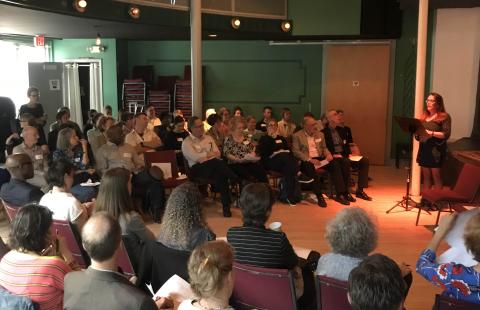What were the specific goals of this creative economy project? Describe the community development challenge or opportunity that your project was designed to address:
The most recent cultural plan for Portland was published in 1998, nearly 20 years before the beginning of this project. Portland had changed dramatically over that time and it has been necessary to re-assess community needs, gaps, and opportunities. Our cultural planning goal was to assess where we are today and to take advantage of alignments of missions, goals, and interests of arts and cultural organizations, city agencies, and stakeholders to make the best use of community assets and achieve ambitious goals of sustainability practices for the creative community. A purpose statement and goal identified by the community in Phase 1 was to “make the collective arts, culture, and creative economy of Portland more visible and provide more support to arts organizations, individuals and creative businesses through collaborations and other means.” Goals for Phase 2 were twofold: 1) reach agreement among the various constituent groups on key issues brought up in Phase 1 and share a draft working agenda with a broader group for input and buy-in, and 2) engage steering committee members to assess data, highlight community progress addressing strategic priorities, and incorporate feedback from workgroup leaders in a living Action Plan with recommendations for tackling those strategies. A written document will be presented for approval by the City Council, which will make Creative Portland eligible to apply for a $75,000 implementation grant (disbursed over three years) from the Maine Arts Commission to address one of the strategies identified in the planning process.
Who was involved in this project and what did they do? (be sure to include the partners from outside of the creative sector and how local voices were included):
Creative Portland hired CivicMoxie (a Boston-based planning, urban design, and placemaking consulting group) to carry out Phase 1 interviews, focus groups, and research into current strategic alignments of Portland’s cultural organizations. Those surveyed represented over 50 creative businesses, arts and cultural organizations, community activists, and city government departments. Three initiatives arose out of Phase 1 and each was led by a member of Portland’s creative community. Creative Portland staff planned and carried out the Phase 2 arts & culture summit with the help of many volunteers from the community. The final report was assembled by Creative Portland staff with input from steering committee members and key stakeholders representing Portland Public Library, the City of Portland Planning Department, USM’s Muskie School of Public Policy, and arts administrators who had been involved in the process for over two years.
How does this project relate to a larger community development strategy?
The City of Portland recently completed a comprehensive plan entitled Portland 2030, which was adopted unanimously by the City Council in June 2017. Members of the City’s planning department were included in all three stages of the cultural planning process, including giving a presentation at Phase 2’s arts & culture summit on where the arts and creative economy are incorporated into Portland 2030. Creative Portland also regularly participates in the Economic Development Steering Committee (EDSC) with the heads of the Economic Development Department, Portland Downtown, Visit Portland, and the Portland Regional Chamber of Commerce.
What projects or places, if any, inspired your approach to this creative economy project?
In Phase 1, prior work done in Portland over the past 20 years was reviewed, including the 1998 cultural plan and the first Creative Economy Summit held in 2008. Community workgroups that arose during Phase 2 looked at Meow Wolf in Santa Fe, New Mexico, and the Torpedo Factory Art Center in Alexandria, Virginia, for inspiration in the pursuit of an art center.
